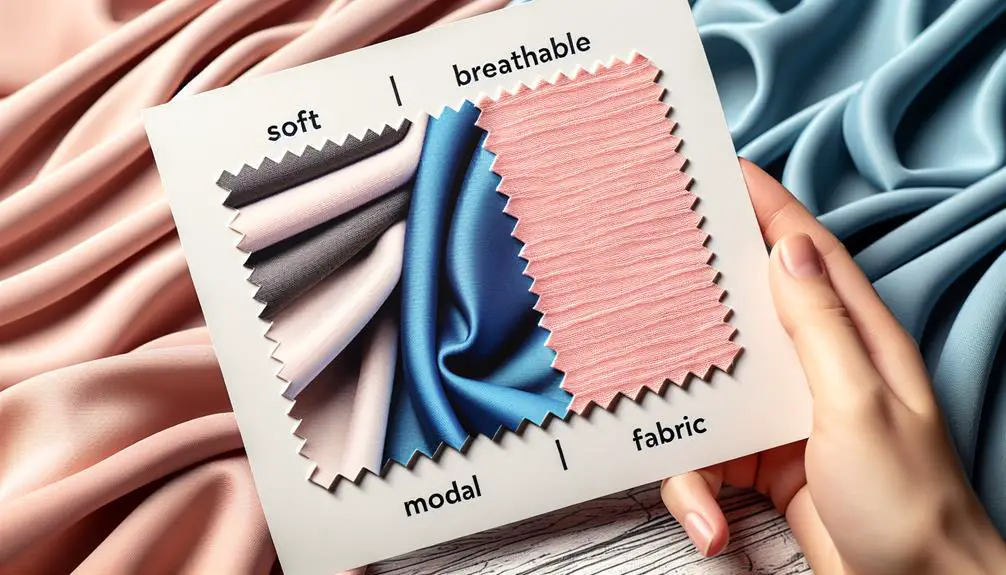I recently bought a modal sheet set after years of using cotton ones, and the difference in feel was surprising. The way these fabrics interact with our skin and environment can make a significant impact on our daily lives.
But is modal really like cotton? Let's explore the characteristics and qualities of both fabrics to uncover the answer.
Table of Contents
Key Takeaways
- Modal, made from beech tree fibers, is softer and more resistant to shrinkage and fading compared to cotton.
- Modal production is environmentally friendly with lower water usage and sustainable processes, unlike water-intensive cotton production.
- Modal's longevity factors include resistance to pilling, shrinking, and better color retention, enhancing garment lifespan.
- Opting for modal offers a cost-effective and quality alternative to cotton, balancing affordability with sustainability.
Modal Vs. Cotton: a Comparison
When comparing modal to cotton, one can easily distinguish their unique characteristics and benefits. Modal, a type of rayon made from beech tree fibers, offers several advantages over traditional cotton. Modal is known for its exceptional softness, often described as even softer than cotton. This luxurious feel makes modal a popular choice for bedding and clothing. Additionally, modal is resistant to shrinkage and fading, maintaining its shape and color wash after wash.
On the other hand, cotton, while a natural and biodegradable fiber, has some drawbacks compared to modal. Cotton production requires a significant amount of water, with estimates suggesting it can take over 20,000 liters of water to produce just one kilogram of cotton. This intensive water usage raises concerns about the sustainability of cotton farming practices. In contrast, modal production is generally considered more environmentally friendly, as beech trees used to make modal require less water to grow compared to cotton plants.
Fiber Structure Differences
Modal and cotton differ drastically in their fiber structures, impacting their properties and performance in various applications. Cotton fibers are natural cellulose, while Modal fibers are semi-synthetic, derived from beech tree pulp through complex production processes. This dissimilarity affects their characteristics greatly.
| Properties | Cotton | Modal |
|---|---|---|
| Fiber Strength | Lower | Higher |
| Flexibility | Less flexible | More flexible |
| Production | Conventional methods | Sustainable processes |
| Sustainability | Natural fiber | Semi-synthetic |
Cotton's lower fiber strength makes it prone to wear and tear compared to Modal's higher strength. When it comes to flexibility, Modal surpasses cotton, being more pliable and resilient. Additionally, Modal's production processes prioritize sustainability, making it a more eco-friendly choice. Understanding these fiber structure variances is important for selecting the most suitable material for different purposes.
Environmental Impact Considerations
Let's talk about how modal and cotton compare when it comes to their environmental impact.
I'll touch on eco-friendly production methods, biodegradability, recyclability, and the energy and water usage involved.
Understanding these factors can shed light on which choice aligns best with our sustainability goals.
Eco-Friendly Production Methods
Considering the environmental impact, sustainable production methods are essential for guaranteeing that modal, like cotton, remains eco-friendly. Implementing sustainable practices and ethical sourcing in modal production can greatly reduce its environmental footprint. By using eco-friendly dyes, reducing water and energy consumption, and ensuring fair labor practices, modal can maintain its status as a sustainable fabric.
Ethical sourcing involves prioritizing suppliers who adhere to environmental regulations and support fair wages for workers. Choosing manufacturers committed to sustainable practices not only benefits the environment but also guarantees social responsibility throughout the supply chain.
Embracing these eco-friendly production methods is vital for modal to uphold its reputation as a sustainable alternative to conventional fabrics like cotton.
Biodegradability and Recyclability
To truly understand the environmental impact of modal and its comparison to cotton, it is important to explore the biodegradability and recyclability aspects of these fabrics. Biodegradable textiles break down naturally, reducing environmental waste, while recyclable fashion allows for materials to be repurposed instead of discarded. Here is a comparison table highlighting key points:
| Aspect | Modal | Cotton |
|---|---|---|
| Biodegradability | Biodegradable | Biodegradable |
| Recyclability | Recyclable | Less recyclable |
| Environmental Impact | Low | Moderate |
Understanding these aspects can help make informed choices when considering the environmental impact of different fabrics.
Energy and Water Usage
Energy and water usage play significant roles in evaluating the environmental impact of textiles like modal and cotton. When considering energy efficiency, modal generally requires less energy to produce compared to cotton. Modal is made from beech trees, which grow quickly and require minimal resources, contributing to its energy efficiency. Additionally, modal production often involves closed-loop processes that recycle water and chemicals, further reducing energy needs.
On the other hand, cotton production is water-intensive, with vast amounts needed for irrigation and processing. Water conservation is a key consideration in sustainable textile choices. By opting for modal over cotton, consumers can support a more energy-efficient and water-conscious industry, making a positive impact on the environment.
Absorbency and Breathability
When it comes to comparing modal and cotton, one key aspect to examine is their absorbency performance and breathability factors.
Absorbency refers to how well a fabric can retain moisture, which is important for comfort. Cotton is known for its high absorbency, quickly soaking up sweat or spills. On the other hand, modal, a type of rayon, also boasts excellent absorbency properties. It can wick moisture away from the body, keeping you dry and comfortable.
Regarding breathability, cotton is highly praised for its ability to allow air to circulate through the fabric, making it ideal for hot and humid climates. Modal, although not as breathable as cotton, still offers good airflow, making it suitable for a wide range of temperatures.
The combination of absorbency and breathability in both modal and cotton makes them popular choices for clothing, bedding, and other textiles where comfort is key.
Comfort and Softness Factor
Both modal and cotton excel in providing a comfortable and soft feel against the skin, making them sought-after choices for various textile applications. When it comes to fabric softness, modal and cotton are both exceptional options. The smoothness and gentle touch of these fabrics make them ideal for clothing items that come in direct contact with the skin.
Here are three reasons why fabric softness and sustainability are important considerations when choosing between modal and cotton:
- Comfort: Both modal and cotton offer a luxurious softness that guarantees a cozy and pleasant wearing experience.
- Environmental Impact: Modal is produced from beech trees, which are a replenishable resource, making it a sustainable choice that minimizes environmental impact.
- Sustainability: Cotton, while soft and comfortable, has a higher water consumption and pesticide usage compared to modal, which raises concerns about its long-term sustainability.
Considering both comfort and environmental impact, modal emerges as a frontrunner in providing a soft and sustainable textile option.
Durability and Longevity
Durability and longevity, modal and cotton each offer distinct characteristics that impact their lifespan and wear over time. When it comes to durability comparison, cotton is known for its strength and ability to withstand frequent washing and wear. However, modal fabric, despite being lighter and softer, can also be quite durable due to its high tensile strength. The longevity factors of modal include its resistance to pilling and shrinking, which can prolong the lifespan of modal garments.
Cotton, on the other hand, may be prone to shrinking and fading over time, especially if not cared for properly. Despite this, cotton's durability is unquestionable, making it a reliable choice for long-lasting clothing items. Considering longevity factors, modal's color retention properties are superior to cotton, ensuring that modal garments maintain their vibrancy for longer periods.
Maintenance and Care Tips
In caring for modal and cotton garments, understanding the specific maintenance and care tips tailored to each fabric can greatly impact their longevity and appearance.
When it comes to laundry care, it's important to wash modal and cotton items in cold water to prevent shrinking and preserve color vibrancy. Use a gentle detergent and avoid harsh chemicals to maintain the fabric's softness. After washing, air-dry your garments to prevent any potential damage from high heat in the dryer.
For storage tips, make sure your modal and cotton pieces are completely dry before putting them away to prevent mold or mildew growth. Store them in a cool, dry place away from direct sunlight to maintain their quality over time.
To prevent wrinkles, hang your modal and cotton garments immediately after washing. If wrinkles do form, use a steamer or iron on a low heat setting to smooth them out without damaging the fabric's fibers.
Price and Affordability Comparison
Let's talk money – how does modal compare cotton price?
Are there cost-effective modal options available, or perhaps more affordable cotton alternatives?
When it comes the price tag, which fabric comes out on top for your budget?
Modal Vs Cotton Prices
When comparing prices between modal and cotton, one can notice a significant difference in affordability. Modal's affordability can be quite appealing, especially when considering the quality it offers compared to cotton.
- Modal Pricing: Modal fabric tends to be more budget-friendly, making it an attractive option for those looking for quality at a lower cost.
- Cotton Costs: Cotton, while known for its quality, can sometimes come with a higher price tag, making it less accessible to those on a tighter budget.
- Value for Money: Opting for modal can provide a good balance between affordability and quality, offering a cost-effective alternative to cotton without compromising on comfort or durability.
Cost-effective Modal Options
For those seeking cost-effective modal options, exploring various brands and retailers can lead to finding quality fabrics at affordable prices. Sustainable fashion isn't just about the environment; it's about making mindful choices that also consider your budget.
Many clothing companies are now incorporating modal into their collections, offering budget-friendly textiles that don't compromise on quality. By choosing modal over conventional materials, you're not only investing in a sustainable wardrobe but also in long-lasting pieces that won't break the bank.
Keep an eye out for sales, discounts, and promotions from your favorite sustainable fashion brands to score even better deals on modal garments. With a bit of research and patience, you can build a stylish and eco-conscious wardrobe without overspending.
Affordable Cotton Alternatives
Exploring affordable cotton alternatives provides a practical way to compare pricing and affordability in sustainable fashion options. When considering sustainable alternatives to cotton, budget-friendly options can make a significant impact.
- Organic Cotton: While slightly pricier than conventional cotton, organic cotton offers a sustainable choice that's gentle on the environment and promotes healthier farming practices.
- Recycled Cotton: Utilizing recycled cotton helps reduce waste and lessens the environmental footprint of clothing production, offering a cost-effective way to support sustainability.
- Hemp: Hemp fabric isn't only durable and breathable but also more affordable than many organic cotton options, making it a versatile and budget-friendly alternative.
Styling and Versatility
Styling modal fabric is a breeze, allowing for endless outfit possibilities and versatility in one's wardrobe. The soft drape of modal makes it perfect for creating flowy silhouettes, whether in tops, dresses, or skirts.
To enhance your look, consider layering a modal blouse with a structured blazer and trousers for a chic office ensemble. For a more casual vibe, pair a modal t-shirt with high-waisted jeans and sneakers for a comfortable yet stylish outfit.
Modal fabric also drapes beautifully, making it a great choice for elegant evening wear. A modal maxi dress with delicate jewelry and heels can effortlessly shift from a dinner date to a special event.
When it comes to styling tips, remember that modal blends well with other fabrics like cotton or spandex, allowing for a range of textures and designs. With its luxurious feel and versatility, modal fabric opens up a world of outfit ideas for any occasion.
Conclusion: Which Is Right for You?
In determining the right fabric for your wardrobe, consider both the comfort and versatility that modal offers, as well as the classic appeal of cotton. Modal provides sustainability benefits due to its eco-friendly production process and biodegradable nature. Its softness and breathability make it a top choice for those who prioritize comfort.
On the other hand, cotton, a timeless favorite, offers natural comfort levels and is easy to care for, perfect for everyday wear. When deciding between modal and cotton, consider the following:
- Environmental Impact: Modal's production uses less water and land compared to cotton, making it a more sustainable choice.
- Durability: While both fabrics are durable, cotton may shrink over time, whereas modal tends to retain its shape and softness even after multiple washes.
- Styling Versatility: Cotton's classic look pairs well with various outfits, while modal's drape and luxurious feel can elevate your wardrobe with a touch of elegance.
Frequently Asked Questions
Can Modal Fabric Shrink in the Wash Like Cotton?
Yes, modal fabric can shrink in the wash like cotton. Shrinkage concerns are important
for both fabrics. However, modal is known for its durability and tends
to hold up better than cotton over time.
Are There Any Specific Environmental Certifications or Standards for Modal Production?
When it comes to sustainability certifications in modal production, there are specific environmental standards to look for. These certifications guarantee that modal fabric is produced in a way that minimizes environmental impact and promotes eco-friendly practices throughout the production process.
How Does the Absorbency of Modal Compare to Cotton in Extreme Humidity?
In extreme humidity, modal's absorbency rivals cotton's, offering exceptional moisture retention and breathability. Its longevity guarantees long-lasting performance. These qualities make modal a top choice for staying comfortable in challenging climates.
Are There Any Specific Maintenance and Care Tips for Modal Fabric That Differ From Cotton?
Taking care of modal fabric involves gentle washing in cold water and avoiding high heat when drying. Modal durability is excellent if properly maintained. Its softness remains luxurious even after many washes, making it a favorite choice.
Is Modal Fabric More Prone to Pilling Than Cotton Over Time?
Over time, modal fabric may be more prone to pilling compared to cotton. To maintain fabric durability, I recommend gentle washing techniques and air drying to prevent shrinkage. Consistent care can help preserve pilling resistance.
- How Does Ring Spun Cotton Affect Garment Fit and Shape Retention? - August 13, 2024
- What Are the Challenges in Producing Ring Spun Cotton? - August 13, 2024
- Is Ring Spun Cotton Suitable for Plus-Size Clothing? - August 13, 2024





